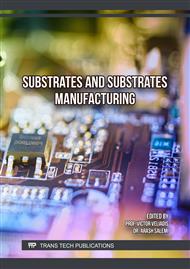[1]
Wolfspeed. N-Type SiC Substrates. https://www.wolfspeed.com/products/materials/ n-type-sic-substrates/. Accessed: 2024-09-02. 2024.
Google Scholar
[2]
Soitec. SmartSiC™ for Automotive Applications. https://www.soitec.com/en/products/ auto-smartsic. Accessed: 2024-09-02. 2024.
Google Scholar
[3]
Séverin Rouchier et al. "150 mm SiC Engineered Substrates for High-Voltage Power Devices". In: Materials Science Forum 1062 (2022), p.131–135.
Google Scholar
[4]
Hitesh Jayaprakash et al. "Study on Estimation of Device Yield in Non-Epitaxial 4H-SiC Material Relating to Defect Densities Influencing Bipolar Degradation with XRT- Measurements". In: Solid State Phenomena 344 (2023), p.53–57.
DOI: 10.4028/p-qymc38
Google Scholar
[5]
Ralf Siemieniec et al. "A SiC Trench MOSFET concept offering improved channel mobility and high reliability". In: 2017 19th European Conference on Power Electronics and Applications (EPE'17 ECCE Europe). 2017, P.1–P.13.
DOI: 10.23919/epe17ecceeurope.2017.8098928
Google Scholar
[6]
Dethard Peters et al. "Performance and ruggedness of 1200V SiC — Trench — MOSFET". In: 2017 29th International Symposium on Power Semiconductor Devices and IC's (ISPSD). IEEE, 2017, p.239–242. ISBN: 978-4-88686-094-1.
DOI: 10.23919/ispsd.2017.7988904
Google Scholar
[7]
Chenming Hu. "Optimum doping profile for minimum ohmic resistance and high-breakdown voltage". In: IEEE Transactions on Electron Devices 26 (1979), p.243–244. URL: https: //api.semanticscholar.org/CorpusID:36831640.
DOI: 10.1109/t-ed.1979.19416
Google Scholar
[8]
M. Kaneko and T. Kimoto. "High-Temperature Operation of n- and p-Channel JFETs Fabricated by Ion Implantation Into a High-Purity Semi-Insulating SiC Substrate". In: IEEE Electron Device Letters 39.5 (2018), p.723–726.
DOI: 10.1109/led.2018.2822261
Google Scholar
[9]
Constantin Csato et al. "Energy filter for tailoring depth profiles in semiconductor doping application". In: Nuclear Instruments and Methods in Physics Research Section B: Beam Interactions with Materials and Atoms 365 (2015), p.182–186.
DOI: 10.1016/j.nimb.2015.07.102
Google Scholar
[10]
Roland Rupp et al. "Alternative Highly Homogenous Drift Layer Doping for 650 V SiC Devices". In: Materials Science Forum 858 (2016), p.531–534.
DOI: 10.4028/www.scientific.net/msf.858.531
Google Scholar
[11]
L. Di Cioccio et al. "Silicon carbide on insulator formation by the Smart-Cut¬Æ process". In: Materials Science and Engineering: B 46.1 (1997), p.349–356.
DOI: 10.1016/s0921-5107(96)02004-1
Google Scholar
[12]
M. Levy et al. "Fabrication of single-crystal lithium niobate films by crystal ion slicing". In: Applied Physics Letters 73.16 (1998), p.2293–2295.
DOI: 10.1063/1.121801
Google Scholar
[13]
Bing Hu et al. 2018 International Flexible Electronics Technology Conference (IFETC): 7-9 Aug. 2018. Piscataway, NJ: IEEE, 2018. ISBN: 9781538633571.
DOI: 10.1109/ifetc42203.2018
Google Scholar
[14]
Marko Swoboda et al. "Laser Assisted SiC Wafering Using COLD SPLIT". In: Materials Science Forum 897 (2017), p.403–406.
DOI: 10.4028/www.scientific.net/msf.897.403
Google Scholar
[15]
David J. Meyer et al. "Epitaxial Lift-Off and Transfer of III-N Materials and Devices from SiC Substrates". In: IEEE Transactions on Semiconductor Manufacturing 29.4 (2016), p.384–389.
DOI: 10.1109/tsm.2016.2599839
Google Scholar
[16]
Stephen W. Bedell et al. "Layer transfer by controlled spalling". In: Journal of Physics D: Applied Physics 46.15 (2013), p.152002.
Google Scholar
[17]
J. A. Bennett et al. "Complete surface exfoliation of 4H–SiC by H+- and Si+-coimplantation". In: Applied Physics Letters 76.22 (2000), p.3265–3267.
DOI: 10.1063/1.126640
Google Scholar
[18]
Shifei Han et al. "Laser slicing of 4H-SiC wafers based on picosecond laser-induced micro-explosion via multiphoton processes". In: Optics & Laser Technology 154 (2022), p.108323.
DOI: 10.1016/j.optlastec.2022.108323
Google Scholar
[19]
Jian Li et al. "Direct bonding of silicon carbide with hydrofluoric acid treatment for high-temperature pressure sensors". In: Ceramics International 46.3 (2020), p.3944–3948.
DOI: 10.1016/j.ceramint.2019.10.123
Google Scholar
[20]
Fengxuan Wang et al. "Low-Temperature Direct Bonding of SiC to Si via Plasma Activation". In: Applied Sciences 12.7 (2022), p.3261.
Google Scholar
[21]
J. Grisolia et al. "Kinetic aspects of the growth of hydrogen induced platelets in SiC". In: Journal of Applied Physics 87.12 (2000), p.8415–8419.
DOI: 10.1063/1.373556
Google Scholar
[22]
L.-J. Huang et al. "Onset of blistering in hydrogen-implanted silicon". In: Applied Physics Letters 74.7 (1999), p.982–984.
DOI: 10.1063/1.123430
Google Scholar
[23]
R. B Gregory, O.W Holland, D.K. Thomas, T.A Wetterroth, S.R Wilson. "The effect of Damage on Hydrogen-implant-induced thin-film seperation from Bulk Silicon Carbode." In: Mat. Res. Soc. Symp. Proc. 572 (1999), p.33–38.
DOI: 10.1557/proc-572-33
Google Scholar
[24]
V. P. Amarasinghe et al. "Properties of H + Implanted 4H-SiC as Related to Exfoliation of Thin Crystalline Films". In: ECS Journal of Solid State Science and Technology 3.3 (2014), P37–P42.
DOI: 10.1149/2.001404jss
Google Scholar
[25]
Voshadhi Pansilu Amarasinghe. "Single Crystalline Silicon Carbide Thin Film Exfoliation for Power Device Applications". Ph.D. Dissertation. Graduate School-New Brunswick Rutgers, The State University of New Jersey, 2015.
Google Scholar
[26]
Madan Sharma et al. "Blistering kinetics in H-implanted 4H-SiC for large-area exfoliation". In: Current Applied Physics 31 (2021), p.141–150.
DOI: 10.1016/j.cap.2021.08.007
Google Scholar
[27]
Volker Häublein and Heiner Ryssel, eds. IIT 2018 proceedings: 2018 22nd International Conference on Ion Implantation Technology, September 16-21, 2018, Congress Centrum, Würzburg, Germany. Piscataway, NJ: IEEE, 2018. ISBN: 9781538668290.
DOI: 10.1109/iit44493.2018
Google Scholar
[28]
Nidec Machine Tool Corporation. Room Temperature Wafer Bonding Machine BOND MEISTER. https://www.nidec.com/en/machine-tool/products/B701/M102/S100/ NMTJ-wafer_bonding_machine/. Accessed: 2024-08-30.
Google Scholar
[29]
Kensuke Ide et. al. "Wafer Bonder Applicable to Devices in Various Fields,Mitsubishi Heavy Industries Technical Review Vol.48 No.1(2011)". In: Mitsubishi Heavy Industries Technical Review 48.1 (2011), p.48–52.
DOI: 10.33737/gpps23-tc-016
Google Scholar
[30]
et. al. S. Langa. "Room Temperature bonding for Vacuum applications : Climatic and long time tests". In: (2004).
Google Scholar
[31]
Zheng Cui. "Wafer Bonding". In: Encyclopedia of Microfluidics and Nanofluidics. Ed. by Dongqing Li. Boston, MA: Springer US, 2013, p.1–7.
Google Scholar
[32]
J. Wong-Leung et al. "Ion implantation in 4H–SiC". In: Nuclear Instruments and Methods in Physics Research Section B: Beam Interactions with Materials and Atoms 266.8 (2008), p.1367–1372.
DOI: 10.1016/j.nimb.2007.12.049
Google Scholar
[33]
Manuel Belanche et al. "Aluminum channeling in 4H-SiC by high-energy implantation above 10 MeV". In: Materials Science in Semiconductor Processing 179 (2024), p.108461.
DOI: 10.1016/j.mssp.2024.108461
Google Scholar
[34]
Kazuya Yamamura et al. "High-Integrity Finishing of 4H-SiC (0001) by Plasma-Assisted Polishing". In: Advanced Materials Research 126-128 (2010), p.423–428.
DOI: 10.4028/www.scientific.net/amr.126-128.423
Google Scholar
[35]
K. Yamamura et al. "Plasma assisted polishing of single crystal SiC for obtaining atomically flat strain-free surface". In: CIRP Annals 60.1 (2011), p.571–574.
DOI: 10.1016/j.cirp.2011.03.072
Google Scholar
[36]
Guillaume Gelineau et al. "Evaluation of Crystal Quality and Dopant Activation of Smart CutTM - Transferred 4H-SiC Thin Film". In: Materials Science Forum 1089 (June 2023), p.71–79.
DOI: 10.4028/p-026sj4
Google Scholar


